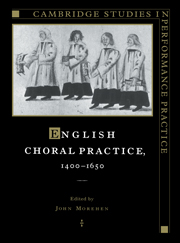Book contents
- Frontmatter
- Contents
- List of plates
- General preface
- Preface
- Abbreviations
- 1 To chorus from quartet: the performing resource for English church polyphony, c. 1390–1559
- 2 Editing and performing musica speculativa
- 3 The sound of Latin in England before and after the Reformation
- 4 English pronunciation, c. 1500 – c. 1625
- 5 Byrd, Tallis and Ferrabosco
- 6 John Baldwin and changing concepts of text underlay
- 7 Sacred songs in the chamber
- 8 The education of choristers in England during the sixteenth century
- 9 The ‘burden of proof’: the editor as detective
- Index of names and places
- Index of manuscript and printed music sources
- Index of works cited
2 - Editing and performing musica speculativa
Published online by Cambridge University Press: 03 March 2010
- Frontmatter
- Contents
- List of plates
- General preface
- Preface
- Abbreviations
- 1 To chorus from quartet: the performing resource for English church polyphony, c. 1390–1559
- 2 Editing and performing musica speculativa
- 3 The sound of Latin in England before and after the Reformation
- 4 English pronunciation, c. 1500 – c. 1625
- 5 Byrd, Tallis and Ferrabosco
- 6 John Baldwin and changing concepts of text underlay
- 7 Sacred songs in the chamber
- 8 The education of choristers in England during the sixteenth century
- 9 The ‘burden of proof’: the editor as detective
- Index of names and places
- Index of manuscript and printed music sources
- Index of works cited
Summary
Nearly 70 years ago H. B. Collins, editing the anonymous early Tudor Mass O quam suavis, and decoding the manuscripts obscure instructions explaining how the notes of the tenor were to be arrived at, became the first editor to face the problem of editing musica speculative a term which I define and discuss elsewhere, but which for present purposes we may briefly describe as music which is conceived and presented in an esoteric format for academic presentation (skill in musica speculativa and musica practica being required by Cambridge of candidates for their music degrees in the early years of the sixteenth century, indicating that musica speculativa involved something beyond simple compositional skill, musica practica Collins naturally and rightly concluded that the notes of the tenor of this mass were not performable in their manuscript layout, since they were presented to suit an esoteric purpose, arranged either with fictional lengths or in the wrong order, and they needed arrangement and realization to form part of an edition that would make sense to modern readers and performers. However, the mass would have been just as unperformable to musicians of the time, and even though no contemporary arrangement survives there can be no doubt that a sixteenth-century performance edition, at least of the tenor, would have been essential.
- Type
- Chapter
- Information
- English Choral Practice, 1400–1650 , pp. 48 - 73Publisher: Cambridge University PressPrint publication year: 1996
- 1
- Cited by



